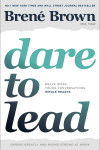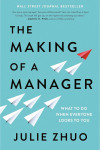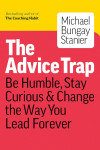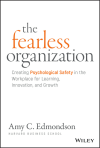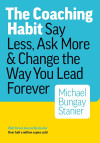Dare to Lead
Brave Work. Tough Conversations. Whole Hearts.
"Dare to Lead" challenges traditional notions of leadership, arguing that true leadership power comes not from authority or control, but from the courage to be vulnerable and the ability to create genuine human connections. Based on two decades of research and interviews with hundreds of global leaders, Brown presents a revolutionary approach to leadership that emphasizes emotional courage, difficult conversations, and wholehearted engagement.
The book dismantles common myths about workplace vulnerability and provides practical tools for developing "brave leaders and courageous cultures." Through extensive research and real-world examples, Brown demonstrates how embracing vulnerability and empathy can transform organizational culture and drive innovation.
At its core, the book provides a framework for developing four key skill sets: facing vulnerability, living core values, building trust, and developing resilience. These skills are presented with concrete practices and actionable strategies that leaders can implement immediately in their organizations.
By reading "Dare to Lead," you will:
- Master the art of vulnerable leadership by understanding how to create psychological safety and encourage honest dialogue, enabling innovation and creativity in your team
- Develop practical skills for having difficult conversations and providing meaningful feedback that builds trust rather than eroding it
- Learn to identify and overcome the behaviors that block effective leadership, including perfectionism, fear of failure, and avoiding difficult conversations
- Create an organizational culture of courage and resilience by implementing specific tools and practices for developing brave leadership at all levels
Related Books
- "The Gifts of Imperfection" by Brené Brown Explores the foundational concepts of authenticity and vulnerability that underpin Dare to Lead's leadership framework.
- "Daring Greatly" by Brené Brown Provides deeper context for understanding vulnerability as a strength rather than weakness in both personal and professional settings.
- "Thinking, Fast and Slow" by Daniel Kahneman Complements Brown's work by explaining the psychological mechanisms behind decision-making and bias in leadership.
- "Radical Candor" by Kim Scott Offers complementary frameworks for having difficult conversations and providing feedback while maintaining care and connection.
1. Vulnerability is a Leadership Strength
Real leadership power comes from the willingness to be vulnerable, not from projecting perfection. Leaders who acknowledge uncertainty, take appropriate risks, and admit mistakes create cultures where innovation thrives because people feel safe to experiment and fail forward.
2. Clear is Kind, Unclear is Unkind
Avoiding difficult conversations or sugarcoating feedback isn’t being nice – it’s being unclear, and unclear leadership is unkind leadership. Direct, respectful communication builds trust and shows you care enough to be honest, even when it’s uncomfortable.
3. Values Must Be More Than Wall Art
Organizational values only matter when they’re translated into specific, observable behaviors. Focus on defining and living two core values rather than having a long list of aspirational statements. Values should guide difficult decisions and everyday actions.
4. Trust is Built in Small Moments
Trust isn’t built through grand gestures but through small moments of keeping commitments, showing up during tough times, and demonstrating consistent behavior. The BRAVING framework (Boundaries, Reliability, Accountability, Vault, Integrity, Non-judgment, Generosity) provides practical ways to build trust daily.
5. Empathy Before Action
The instinct to jump to problem-solving can shut down meaningful connection. Strong leaders practice empathy by staying present with discomfort and truly listening before moving to solutions. This builds psychological safety and encourages honest dialogue.
6. Perfectionism is a Defense Mechanism
What looks like high standards is often fear in disguise. Perfectionism prevents meaningful innovation and connection because it’s rooted in the question “What will people think?” rather than “What is the right thing to do?” Daring leaders focus on learning and growth instead of flawless execution.
7. Culture is Built or Destroyed in Tough Moments
How leaders handle failure, setbacks, and difficult conversations sets the tone for organizational culture. Creating a “brave culture” requires modeling vulnerability, rewarding courage, and treating failures as learning opportunities rather than sources of shame.
Q: How does vulnerability differ from weakness in leadership?
A: Vulnerability is the courage to show up when you can’t control the outcome. Unlike weakness, it requires significant emotional strength and is the birthplace of innovation, creativity, and change.
Q: How can leaders balance vulnerability with maintaining professional boundaries?
A: The book provides clear guidelines for appropriate vulnerability - sharing experiences that are “walking through” not “living in,” and focusing on learned insights rather than raw emotions.
Q: What’s the practical first step in becoming a more daring leader?
A: Start by identifying your two core values and defining observable behaviors that demonstrate these values in action. This provides a foundation for authentic leadership decisions.
Q: How do you handle resistance to vulnerable leadership in traditional organizations?
A: The book recommends starting with small “rumbles” - structured conversations about specific challenges - and gradually building psychological safety through consistent behavior.
Q: How do you implement feedback practices that build rather than break trust?
A: The book advocates for “painting done” first - clearly defining what success looks like - then providing feedback from a place of caring and service, always tied to clear expectations and values.
Q: What’s the difference between empathy and sympathy in leadership?
A: Empathy involves connecting with the feeling that someone is experiencing, while sympathy is trying to make people feel better or solve their problems. Leaders need to practice empathy by staying with discomfort rather than jumping to solutions.
Q: How do you maintain vulnerability when facing criticism or failure?
A: The book introduces the “reckoning, rumble, revolution” framework: acknowledge the emotional impact (reckoning), stay curious and honest about the story you’re telling yourself (rumble), and use the learning to write a new ending (revolution).
Q: How can organizations practically build cultures of courage?
A: Start with clear behaviors that define courage in your context, train leaders in specific skills like giving feedback and having difficult conversations, and reward rather than punish appropriate risk-taking and vulnerability.
- When transitioning from technical expertise to people leadership: The book provides crucial guidance for maintaining authenticity while developing new leadership capabilities.
- During organizational culture transformation: Particularly valuable when trying to build psychological safety and move from a command-and-control to a trust-based culture.
- After experiencing leadership challenges around difficult conversations: Offers practical tools for having tough discussions while maintaining connection and trust.
- When feeling burnout from maintaining a “perfect” leadership facade: Helps release perfectionism and develop more sustainable leadership practices.

Your support helps me maintain and improve the book recommendations for everyone.
